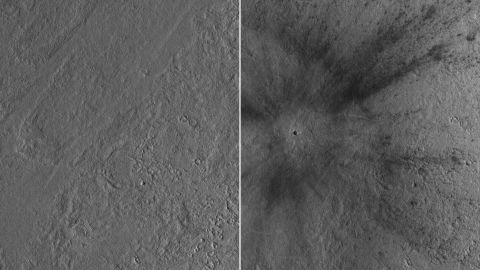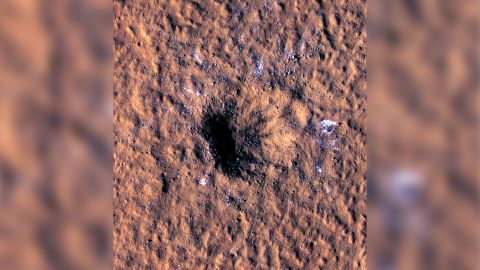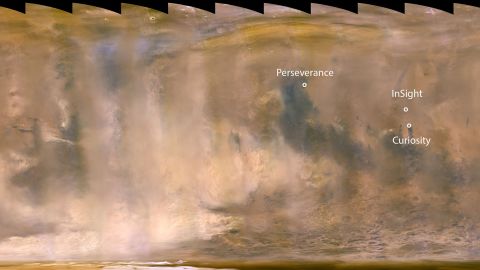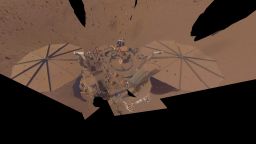last December when the lander detected a massive quake on Mars.
Now, scientists know what caused the red planet to rumble. A meteoroid slammed into Mars 2,174 miles (3,500 kilometers) away from the lander and created a fresh impact crater on the Martian surface.
The ground literally moved beneath InSight on December 24, 2021, when the lander recorded a magnitude 4 marsquake. Before and after photos captured from above by the Mars Reconnaissance Orbiter, which has been circling Mars since 2006, spotted a new crater this past February.
When scientists connected the dots from both missions, they realized it was one of the largest meteoroid strikes on Mars since NASA began studying the red planet. Images from the orbiter’s two cameras showed the blast zone of the crater, which allowed scientists to compare it with the epicenter of the quake detected by InSight.
The journal Science published two new studies describing the impact and its effects on Thursday.
The space rock also revealed boulder-size ice chunks when it slammed into Mars. They were found buried closer to the warm Martian equator than any ice that has ever been detected on the planet.
“The image of the impact was unlike any I had seen before, with the massive crater, the exposed ice, and the dramatic blast zone preserved in the Martian dust,” said Liliya Posiolova, orbital science operations lead for the orbiter at Malin Space Science Systems in San Diego, in a statement.
[…]
When the meteoroid crashed into Mars, it created a crater in the planet’s Amazonis Planitia region spanning 492 feet (150 meters) across and 70 feet (21 meters) deep. Some of the material blasted out of the crater landed as far as 23 miles (37 kilometers) away. Teams at NASA also captured sound from the impact, so you can listen to what it sounds like when a space rock hits Mars.
The images captured by the orbiter, along with seismic data recorded by InSight, make the impact one of the largest craters in our solar system ever observed as it was created. Mars is littered with massive craters, but they’re much older than any mission to explore the red planet.
[…]
Ice beneath the Martian surface could be used for drinking water, rocket propellant and even growing crops and plants by future astronauts. And the fact that the ice was found so near the equator, the warmest region on Mars, might make it an ideal place to land crewed missions to the red planet.
[…]
Sadly, InSight’s mission is running out of time. Increasing amounts of dust have settled on the lander’s solar panels, only exacerbated by a continent-size dust storm detected on Mars in September, and its power levels keep dropping.
Fortunately, the storm didn’t pass over InSight directly — otherwise, the darkness of the storm would have ended the mission. But the weather event has kicked a lot of dust up into the atmosphere, and it has cut down the amount of sunlight reaching InSight’s solar panels, said Bruce Banerdt, InSight principal investigator at NASA’s Jet Propulsion Laboratory in Pasadena, California.
The mission scientists estimate InSight will likely shut down in the next six weeks, ending a promising mission to unlock the interior of Mars.
[…]
Source: Space rock slams into Mars and reveals buried ice | CNN

Robin Edgar
Organisational Structures | Technology and Science | Military, IT and Lifestyle consultancy | Social, Broadcast & Cross Media | Flying aircraft




